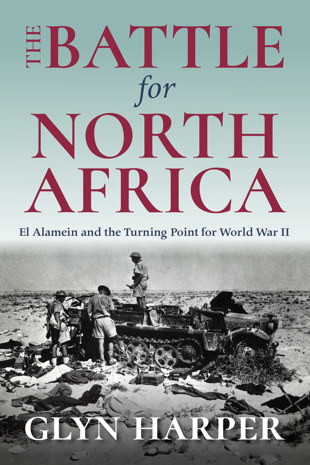1. In a nutshell, what were the battles of El Alamein, and in what way were they the turning point in the war?
Three battles were fought on the El Alamein position in mid to late 1942. It was the last viable defensive position in Egypt and if it was broken, the British would have had to evacuate Egypt and lose the vital life-line of the Empire, the Suez Canal. The first battle — fought in July — halted Rommel at El Alamein; the second — fought in August and September — defeated Rommel’s last attempt to break through; and the final battle shattered his Italian–German Army in what was a decisive defeat.
2. When they were over Winston Churchill said of them that it was the beginning of the end. Was he right?
No, Churchill was wrong. The war still had three long years to run. But Churchill was absolutely correct when he later wrote that the October battle was ‘the Hinge of Fate’. That is, it was a key turning point in the war.
3. What did your research involve?
Research in four separate national archives and military museums in the USA, UK, Australia and New Zealand. Plus reading all the secondary source books available on North Africa and El Alamein.
4. Seventy-five years on, is El Alamein still fertile ground for a military historian?
El Alamein is still very fertile ground for a military historian. Several controversial issues still arouse passion. Different explanations have been given for the outcome, and there is quite a bit of argument over who made the greatest contribution to the outcome of the battle. Montgomery is a polarising figure, too. He did not help his case much when he stated that the battle had gone entirely to plan. It did not — and Montgomery had to improvise along the way, which caused considerable alarm to the political and military authorities in London.
5. Rommel — military genius?
Rommel was a very good field commander but he was far from a military genius. I think this book shows why.
6. The British command didn’t emerge from this terribly well. How so?
The British, despite numerical superiority, went from disaster to disaster in North Africa until Montgomery’s arrival. Most of the reasons for these disasters were self-inflicted and it almost caused a mutiny by the various dominion commanders in Eighth Army. I was tempted to call the book Churchill Finds a General after a well-known book on the American civil war. It took two long years and a succession of military disasters to find a British military commander who could match Rommel in the field. That was Montgomery, and he got the job by accident. Churchill’s preferred choice, Lieutenant General Gott, was killed when his transport plane was shot down.
7. Who were the heroes of El Alamein?
The heroes were the allied airmen and soldiers on the ground who were doing the fighting and dying. The October battle was a true battle of attrition and the fighting infantry units bore the brunt of the casualties. Some infantry battalions suffered more than 50 per cent casualties. One armoured brigade, the 9th Armoured, fighting with New Zealanders, had over 90 per cent casualties in the final action that broke Rommel’s Panzerarmee. The Australian and New Zealand soldiers especially made a vital contribution to the battle’s outcome.
8. What’s one new thing you learnt while working on this book?
The total success of the allied deception plans. Rommel described El Alamein as a ‘battle without hope’ and wrote to his wife that his army was ‘being crushed by the weight of the enemy’. In reality, the forces were pretty evenly matched, but British deception operations had convinced Rommel (and German higher headquarters) that the British Eighth Army was 40 per cent stronger in armour and 45 per cent stronger in infantry than it actually was. These inflated figures and the fictitious 25 Corps remained in German intelligence estimates until the end of the war. Incidentally, one of the bogus divisions created was from New Zealand.
9. What’s the particular delight of being a military historian?
There are many. Looking at material in archives that no one has read for years gives a real thrill. Being able to tell a story using new source material is great. And there is never any shortage of quality subject matter. War brings out the best and worst in people, which can be compelling. As an author it is very rewarding when someone says how much they learned from your book.
10. What are you reading at the moment, for work and for pleasure?
Reading for work (a pleasure, too): a history of the British Army and its image during the First World War by Stephen Badsley. For pleasure: I like thrillers/adventures. During my last break I read The Nowhere Man by Greg Hurwitz (the sequel to Orphan X).


